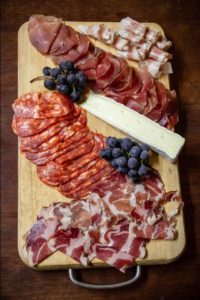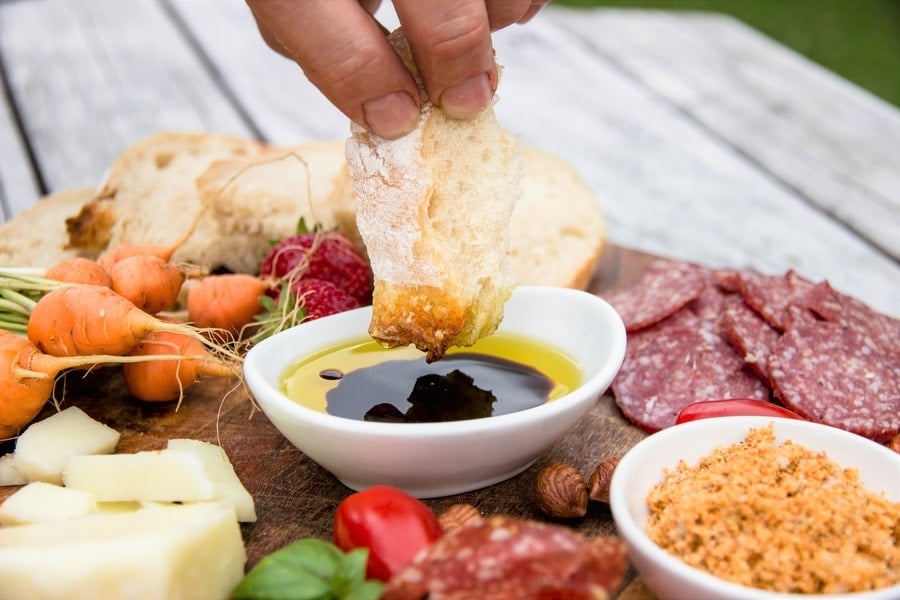Choosing the finest dry-cured charcuterie meat – in the Western world there are many options available.
I have a deep appreciation for the traditionally made long-term production of these dry-cured meats since I also make them myself.
Of course, there is a huge variation in what is available. I want to be as useful as possible and help you select the type of thin dry-cured charcuterie meats that will be excellent on your charcuterie board.
The dry cured meat is the showcase of the charcuterie board, or for that matter antipasti. It’s not the place for cheap supermarket salamis that take less than 1 week to produce. It’s for honored traditions and thousands of years of history to be showcased in the food (in my opinion).
Best Thin and Finest Meats for a Charcuterie Board
The finest thin meat you can get in the world is Prosciutto de Parma, Jamón ibérico, and Culatello. These fine cured meats come from quality animals, are expertly made, are protected by strict regulations, and take at least 12 months to produce.
Now there are always new ideas and products when it comes to dry cured meats, but the tradition and culture behind Prosciutto de Parma and Iberian Jamón go back many hundreds of years.
You could say they have been tested through time, don’t get me wrong, there are many new flavors and also small artisanal products that have become epic as cured meat for charcuterie boards.
I strongly suggest that you seek anything you can get that is local and reputable. However, the above-cured meats are also able to produce volume at a high quality.
There are different degrees of quality within each category, and I recommend you try them depending on your budget – for example, prosciutto is dried for one year up to five years.
These types of meats are wafer-thin because the salt content is higher to preserve and dry the meat. If you don’t have the meat see-through and wafer-thin, the saltiness can be overwhelming.
Either an expert with a prosciutto knife or a deli slicer (with a tolerance to cut less than 1mm) is necessary to get these very fine slices.

Base it on the Experts – Italian Antipasti/Antipasto
If you look at the classic Italian meat and cheese antipasti, charcuterie boards (to help, I have a calculator for how much meat etc. per person I created), good quality prosciutto from different regions of Italy is often the showcase meat.
What Meats go Well on a Charcuterie Board?
Classic meats for charcuterie boards take months if not years to dry. Cured meats like prosciutto or Jamon have proteins that are broken down over the long drying process of dry-cured meats.
Some Italian university studies I read, have highlighted that this type of amino acid protein is more easily broken down in our digestive system. Therefore, this is a healthy way to consume protein.
What is often found with charcuterie meat that goes well in a charcuterie board is that the wafer-thin slices electrically melt in your mouth.
What most people don’t realize is that dry-cured charcuterie meat has lost more than 40% of its original weight, so it is a much-dense source of protein. It’s mainly the water inside the muscle that has been lost which will intensify any good quality meat.
This is one of the reasons why these epic charcuterie meats go so well on a charcuterie board.
What kind of Salami is best for Charcuterie?
Good quality salami types for charcuterie boards:
- Genoa
- Sopressatta
- Felino
You’ll find most good dry-cured salamis contain pepper and garlic which have antiviral and anti-fungal antibacterial beneficial properties. Hundreds of years ago it made a lot of common sense to use things that had natural benefits to assist in the preservation of this preserved meat.
Sometimes good dry-cured salami that takes months to make becomes cold and hard. It has this firmness because it lost the water content as part of the drying process. This is for whole muscle and salami dry cured traditionally.
Carefully dried and the firm is the key.
Wafer thin when served.
What Are the Essentials for a Charcuterie Board?
I like to keep the charcuterie board essentials classic:
- Quality Dry Cured Meat
- Quality soft or sweet styles of cheese
- Dry bubblies like Prosecco, or smooth young unoaked wines either red or white. I like to think a lighter wine.
- olives – green not overpowering
- fresh quality bread
Tips for Making Amazing Charcuterie Boards
- Color and Contrast
- Don’t Over Fill the Charcuterie Board
- Less is More, Savor and Appreciate a Special Craft
- Tasting Platter not a Full Course Meal
- Cut the Fat with Acidic Foods
Color and Contrast
The red hue color of thinly sliced dry-cured charcuterie meat always contrasts well with the yellow pale colors of cheese, the green olives, and white-collar of bread.
Taking a lesson from Japanese cuisine, I have heard they like to serve dishes with at least five different colors on the plate.
I’ve even started thinking more about the actual wooden charcuterie board I’m placing my cured meats on. And using pale-colored wood to showcase the transparent red color of the charcuterie meat.
Don’t Over Fill the Charcuterie Board! I noticed in Italy antipasti and antipasto boards are not overfilled and do not look like the food is squashed tightly together on the wooden board.
Laying out the meat carefully with a small amount of overlap but keeping some gaps in between. In a way a kind of art form.
Less is More
I always try to remind myself that less is better than too much when it comes to a charcuterie board or any other type of food. So the lesson I learned as a consultant around fine dining restaurants – you always want people to get satisfied but not overly stuffed.
Take the same approach towards meat and cheese platters.
Tasting Platter
On the odd occasion, I have used a charcuterie board with all my cured meats as a main event. But really, as it is a small quantity of food it should be savored – that is my opinion!
After all, it is a celebration of meat that has taken months if not years to make!
Cut the Fat with Acidic Foods
Some kind of green olives, I find this a good contrast, it’s very common in many styles of food that you use acid to contrast the fat.
Having a little ceramic of extra-virgin olive oil, with some decent balsamic vinegar dribbled in the middle. It looks very presentable since the vinegar is separated from the oil as it is served. Then with freshly baked sourdough or some other type of delicious bread, you can tippet both olive oil and balsamic at the same time, delicious!

Matching Alcohol with Charcuterie
Here is a link to an article I wrote recently on this, in short, dry bubbly as mentioned.
Montepulciano or simple merlot, maybe easy dry Rieslings

Tom Mueller
For decades, immersed in studying, working, learning, and teaching the craft of meat curing, sharing the passion and showcasing the world of charcuterie and smoked meat. Read More
